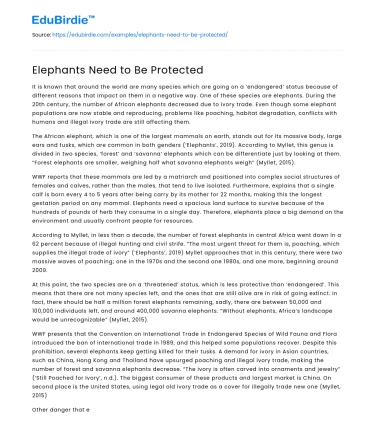It is known that around the world are many species which are going on a ‘endangered’ status because of different reasons that impact on them in a negative way. One of these species are elephants. During the 20th century, the number of African elephants decreased due to ivory trade. Even though some elephant populations are now stable and reproducing, problems like poaching, habitat degradation, conflicts with humans and illegal ivory trade are still affecting them.
The African elephant, which is one of the largest mammals on earth, stands out for its massive body, large ears and tusks, which are common in both genders (‘Elephants’, 2019). According to Myllet, this genus is divided in two species, ‘forest’ and ‘savanna’ elephants which can be differentiate just by looking at them. “Forest elephants are smaller, weighing half what savanna elephants weigh” (Myllet, 2015).
Save your time!
We can take care of your essay
- Proper editing and formatting
- Free revision, title page, and bibliography
- Flexible prices and money-back guarantee
WWF reports that these mammals are led by a matriarch and positioned into complex social structures of females and calves, rather than the males, that tend to live isolated. Furthermore, explains that a single calf is born every 4 to 5 years after being carry by its mother for 22 months, making this the longest gestation period on any mammal. Elephants need a spacious land surface to survive because of the hundreds of pounds of herb they consume in a single day. Therefore, elephants place a big demand on the environment and usually confront people for resources.
According to Myllet, in less than a decade, the number of forest elephants in central Africa went down in a 62 percent because of illegal hunting and civil strife. “The most urgent threat for them is, poaching, which supplies the illegal trade of ivory” (‘Elephants’, 2019) Myllet approaches that in this century, there were two massive waves of poaching; one in the 1970s and the second one 1980s, and one more, beginning around 2009.
At this point, the two species are on a ‘threatened’ status, which is less protective than ‘endangered’. This means that there are not many species left, and the ones that are still alive are in risk of going extinct. In fact, there should be half a million forest elephants remaining, sadly, there are between 50,000 and 100,000 individuals left, and around 400,000 savanna elephants. “Without elephants, Africa’s landscape would be unrecognizable” (Myllet, 2015).
WWF presents that the Convention on International Trade in Endangered Species of Wild Fauna and Flora introduced the ban of international trade in 1989, and this helped some populations recover. Despite this prohibition, several elephants keep getting killed for their tusks. A demand for ivory in Asian countries, such as China, Hong Kong and Thailand have upsurged poaching and illegal ivory trade, making the number of forest and savanna elephants decrease. “The ivory is often carved into ornaments and jewelry” (‘Still Poached for Ivory’, n.d.). The biggest consumer of these products and largest market is China. On second place is the United States, using legal old ivory trade as a cover for illegally trade new one (Myllet, 2015)
Other danger that elephants are going through is habitat loss and fragmentation. Most of their habitats surpasses the protected areas (‘Still Poached for Ivory’, n.d.). The Save the Elephants website explains that with overpopulation comes infrastructure development. The expansion of human settlements such as the construction of infrastructure, railways and roads are the reasons of the reduction of their habitats, therefore decreasing the amount of grass that they consume, since they are herbs. Furthermore, this causes elephant groups to separate, making their breeding chances diminish and this in turn is not healthy for the genetic diversity of the elephant population (‘Threats to Elephants’, n.d.)
According to the Save the Elephants website, another factor that has negative effect on elephants’ lives are conflicts with people who surround their habitats. As Africa’s population grows, elephants’ rangeland, where they tend to roam, is converted to agriculture, and this land becomes a target for hungry elephants that are looking for food. “A year’s crop can be wiped out in a single night, creating understandable resentment” (‘Threats to Elephants’, n.d.). If elephants and farmers confront each other, both can be severely affected and be wounded or killed. Also, the constant livestock grazing in the elephant’s land is decreasing the amount of food available for elephants, and this increases the chances of herders being attacked by nervous elephants.
In conclusion, as shown by the information presented in this essay, there are many factors that negatively affect the elephant population and ultimately lead to a decrease in its number. I believe that people should come to their senses and do everything possible to save this beautiful species of animals.






 Stuck on your essay?
Stuck on your essay?

